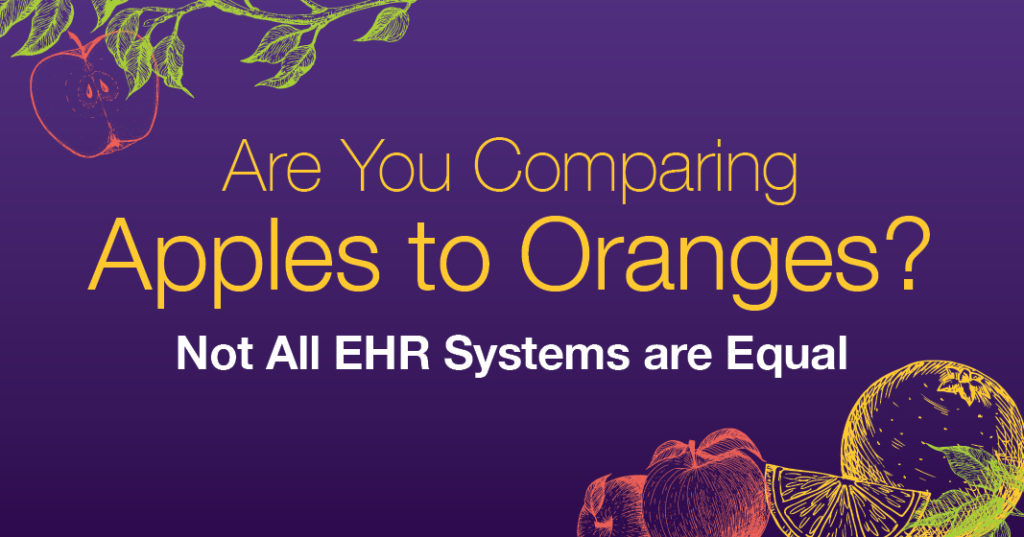Comparing Ophthalmology EHR Software?

Ophthalmology EHR system vendors go to great lengths to tell you how different their systems are. From innovative technology to award-winning customer service, they insist that their EHR is the best choice for your ophthalmology practice. I know because, as an ophthalmologist, I, too, get all of the emails, see the ads and hear all of the elevator pitches touting just that. And you know what conclusion I’ve come to? It turns out that some of them are actually correct.
Now don’t get me wrong. There are many, many systems out there that are virtually the same. Sure, the screen may look a bit different and the product names are dissimilar, but the end result is always the same. Me, staying late, working weekends and wondering why the EHR system that’s supposed to save me time is causing me more pain than ever before.
So when I do come across an EMR system, like Modernizing Medicine’s system, EMA™, that actually does what it says it can do, first, I’m excited. But then I want to share it with my colleagues. Problem is, when I try to extol the virtues of EMA in comparison to another ophthalmology EMR system, it’s like trying to compare apples to oranges. They just aren’t the same.
To help combat some of the misleading information that’s out there, I’ve put together a list of EMA’s benefits compared to where other vendors fall short of their promises. While it’s not an exhaustive list, if you find yourself looking for a new system or not liking the ophthalmology software you have, it should serve as a handy tool when speaking with other EHR vendors.
An EHR system is vital to running a prosperous practice, so make sure you understand the differences before committing to such an important investment.
Ease of Use
Efficiency and intuitiveness—two key reasons why I find Modernizing Medicine’s EHR system to work so well. It turns out that others feel the same way, judging by the fact that Black Book Research ranks it #1 in ophthalmology.
Part of what makes it so intuitive and easy to use is that it was built by ophthalmologists and maintained by five on-staff ophthalmologists. So it’s geared towards minimizing the things that drive us crazy—extra, unnecessary steps and data reentry. When an ophthalmology EMR is not built by those in the know, it can make for a very poor experience.
| Things to Look For | Things to Look Out For |
|---|---|
| Drawing tools backfill as findings | Drawing tools don’t backfill as findings |
| Multi-image view | Side-by-side image view only |
| Master visits for frequently encountered conditions | No Protocols for master visits |
| Dictation & little to no typing | Much more typing |
Leading Technology
Some EHR systems are server-based, even if they say they’re on the Cloud. So as your practice grows, you need to acquire more hardware. EMA is a true Cloud Software as a Service (SaaS) solution, which is much more scalable than a server-based model. It’s also a native mobile app. Ultimately, performance can suffer when applications aren’t optimally architected to run on the Web.
| Things to Look For | Things to Look Out For |
|---|---|
| Speed and performance | Slow screen redraws and render times |
| True Cloud Software as a Service (Saas) | Server model |
| No need to purchase additional EHR servers or workstation licenses | Requires additional servers or workstation licenses |
All-in-One System
Hopping from one system to the next is inefficient. The issue is, there are a lot of systems out there that don’t include a practice management system, leaving room for duplicate entry, miscommunication and, quite possibly, errors.
With an all-in-one system, communication is streamlined and everything is captured once. Less redundancy. More productivity. It’s a great way to save time in an already very busy day.
| Things to Look For | Things to Look Out For |
|---|---|
| One database built from the ground up | Bridge issues |
| Log in once for your entire system | Multiple sign in to clinical and practice management systems |
| Enter information just once to cut down on duplicate effort | Input information more than once |
Comprehensive Automation
An EMR system should help you focus on the patient and outcomes, not the coding and billing. With EMA, many of the details are taken care of automatically as you document. By the time you leave the exam room, the documentation is essentially over. If you find yourself with an EMR system with limited automation, you could be manually doing a lot of the tasks you shouldn’t have to do.
| Things to Look For | Things to Look Out For |
|---|---|
| Suggests CPT and ICD-10 codes with laterality and specificity | Does not suggest CPT and ICD-10 codes with laterality and specificity |
| Populates modifiers including global periods | Manual entry of global periods |
| Coding performed in the background while you document | Coding is done by you |
Client Support
Have you ever had a great product with poor customer service? Or a poor product with great customer service? It makes a difference in your overall opinion of the product, right? That’s because a product is only as good as the support you receive. It can really make or break the success you have with it. At Modernizing Medicine, you get a great product with amazing customer support that wins awards—including the 2017 Customer Success Team of the Year.
| Things to Look For | Things to Look Out For |
|---|---|
| Quality onsite EHR training available | Minimal onsite EMR training |
| Support members with actual ophthalmology experience | No ophthalmology experience |
| Award-winning support | Poor customer service ratings |
MIPS Excellence
There were a lot of vendors out there claiming that they were ready for MIPS. It turns out, some probably weren’t. When a portion of your hard-earned revenue is on the line, make sure you go with an EHR that has a built-in MIPS solution that collects your MIPS data within the flow of the exam and easily reports to ophthalmology-specific registries. This will help you out tremendously.
| Things to Look For | Things to Look Out For |
|---|---|
| Use IRIS or a Modernizing Medicine registry to transmit necessary patient data directly to CMS | Poor or no connection to IRIS or other registries |
| MIPS dashboard automates your score in near-real time as you document* | Not knowing your estimated MIPS score before you submit |
*Information relating to our EHR certification, including certain costs and limitations, can be found at www.modmed.com/costs-and-limitations.
Simple Customization
Many EHR systems are template-based, requiring lots of customization per provider. But would you rather spend your time on important issues or learning how to program software? Sure, they say it’s easy to customize, but it’s usually not. And, often, you’ll have to call their team to make those changes anyway.
EMA removes burdensome templates and any personalization added is unique per provider. And you don’t have to call the support team to do it.
| Things to Look For | Things to Look Out For |
|---|---|
| Customization of talk tracks without the need to call support | Calling support to make any customization changes |
| Adaptive learning adjusts to each provider | Templates that require substantial customization |
Intangibles
Performance matters, but so do other factors that go into the development of an EHR system. Modernizing Medicine is a larger company that focuses its robust resources on continuous product development and improvement. With smaller companies, they often don’t have the resources to devote to making their products better. So when you need something fixed, it can take a long time.
| Things to Look For | Things to Look Out For |
|---|---|
| Larger company that has resources and staff focused on continuously improving and updating products | Smaller companies that do not have the resources or staff to continuously improve or update products |
| More developers, updates and on-staff physicians who code | Less development and product updates |





